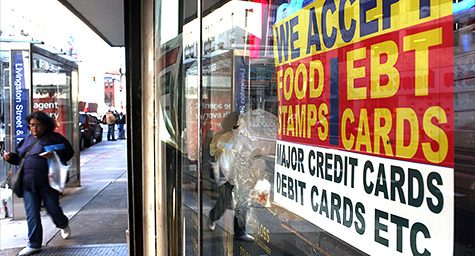USDA Stops Measuring ‘Hunger,’ Focuses on ‘Food Security’
Scarlett O’Hara famously declared, “As God is my witness, I’ll never be hungry again.” Now, thanks to the U.S. Department of Agriculture, nor will anyone else.
Every year, the Agriculture Department issues a report that measures Americans’ access to food, and it has consistently used the word “hunger” to describe those who can least afford to put food on the table. But not this year. Mark Nord, the lead author of the report, said “hungry” is “not a scientifically accurate term for the specific phenomenon being measured in the food security survey.” Nord, a USDA sociologist, said, “We don’t have a measure of that condition.”
The USDA said that 12 percent of Americans — 35 million people — could not put food on the table at least part of last year. Eleven million of them reported going hungry at times. Beginning this year, the USDA has determined “very low food security” to be a more scientifically palatable description for that group. The United States has set a goal of reducing the proportion of food-insecure households to 6 percent or less by 2010, or half the 1995 level, but it is proving difficult. The number of hungriest Americans has risen over the past five years. Last year, the total share of food-insecure households stood at 11 percent.[…]
Among several recommendations, the panel suggested that the USDA scrap the word hunger, which “should refer to a potential consequence of food insecurity that, because of prolonged, involuntary lack of food, results in discomfort, illness, weakness, or pain that goes beyond the usual uneasy sensation.” To measure hunger, the USDA determined, the government would have to ask individual people whether “lack of eating led to these more severe conditions,” as opposed to asking who can afford to keep food in the house, Nord said.
From a scientific standpoint, “food security” is not only more easily measurable but a more accurate description of what the observed phenomenon measure. It’s also a term that has had long currency among the non-governmental organizations that seek to prevent starvation in the developing world. Still, from a public relations standpoint, it might have been better to make the terminology change in a year when the trend was going in the other direction.
From an anecdotal standpoint, though, I find it difficult to believe that twelve percent of Americans don’t have enough to eat. Most people I encounter seem to have far, far too much and the few who are unusually skinny seem to be quite well off materially, at least judging from their clothes. Even the homeless and beggars I see when I visit DC appear healthy enough.
 More importantly, while the idea that a huge number of Americans are going hungry because they can’t afford food is a shocking one, it’s far from clear that the numbers here show that. While twelve percent are in the “very low security” category, less than a third of that group actually had someone go without eating for a single day in 2005. Their lack of security was mostly in worry that they would go hungry, not in the actual fact thereof. That’s sad, too, to be sure. But it’s not the same thing.
More importantly, while the idea that a huge number of Americans are going hungry because they can’t afford food is a shocking one, it’s far from clear that the numbers here show that. While twelve percent are in the “very low security” category, less than a third of that group actually had someone go without eating for a single day in 2005. Their lack of security was mostly in worry that they would go hungry, not in the actual fact thereof. That’s sad, too, to be sure. But it’s not the same thing.






When I was in college, several of my friends went hungry from time to time because they were new to this “budgeting” thing and spent most of their money on luxuries early in the month. Would they have counted in the USDA ‘food security’ statistics?
There seems to be a disconnect in the report and your write up.
The USDA said that 12 percent of Americans — 35 million people — could not put food on the table at least part of last year.
While twelve percent are in the “very low security†category, less than a third of that group actually had someone go without eating for a single day in 2005.
So apparently “part of the year” means one meal as only 31% said they didn’t eat for a day.
I also found these statistics an interesting contrast. 96% in the “low security” said the food did not last and they did not have money to get more (just to be clear is this no money or no money and no food stamps). 44% said they lost weight because they did not have enough money for food. So apparently 52% ran out of money for food, but did not lose weight because of this and 65% ran out of money but didn’t go hungry for the day. This would appear to be very transitory running out of money, with little real impact on food intake.
My wife fasts once a week voluntarily. So would she get counted in the 31% who missed a day of food?
It is also unclear to me from the write up (thank old media) if this is measured like poverty in the US (aka before government assistance).
Thanks to a very slow day at work, a haiku:
I am twelve percent.
I thought my food was secure.
Limbaugh stole my pie.
Most people I encounter seem to have far, far too much
Comment would be superfluous.
How dare you make the argument that people are responsible for their own circumstances! What on Earth would the Dems do to ‘help’ these people!
This is America. People who are ‘starving’ do so by choice. There are plenty of resources from churches, to soup kitchens, to financial assistance, that they choose not to utilize.